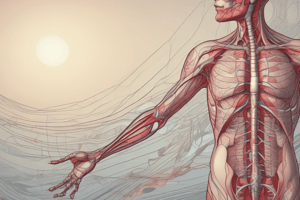Podcast
Questions and Answers
Which artery supplies the brain by entering the skull cavity?
Which artery supplies the brain by entering the skull cavity?
- Brachial artery
- Internal carotid artery (correct)
- External carotid artery
- Femoral artery
What is the order in which the major arteries emerge from the aortic arch?
What is the order in which the major arteries emerge from the aortic arch?
- Left subclavian artery, Left common carotid artery, Brachiocephalic trunk
- Brachiocephalic trunk, Left common carotid artery, Left subclavian artery (correct)
- Left common carotid artery, Brachiocephalic trunk, Left subclavian artery
- Brachiocephalic trunk, Left subclavian artery, Left common carotid artery
At what vertebral level does the aorta bifurcate into the common iliac arteries?
At what vertebral level does the aorta bifurcate into the common iliac arteries?
- L3 vertebra
- L4 vertebra (correct)
- L2 vertebra
- L5 vertebra
Which of the following arteries continues as the femoral artery to supply the lower extremity?
Which of the following arteries continues as the femoral artery to supply the lower extremity?
What structure forms the superior vena cava?
What structure forms the superior vena cava?
Which artery supplies blood to the upper extremity after branching from the subclavian artery?
Which artery supplies blood to the upper extremity after branching from the subclavian artery?
What are the branches of the popliteal artery?
What are the branches of the popliteal artery?
Which vein is responsible for draining venous blood from the lower extremities?
Which vein is responsible for draining venous blood from the lower extremities?
Flashcards
Aorta
Aorta
The largest artery in the body, responsible for carrying oxygenated blood to the rest of the body. It originates from the left ventricle of the heart and runs down the chest and abdomen.
Aortic Arch
Aortic Arch
The curved portion of the aorta that lies above the heart. It gives rise to the three main arteries that supply the head, neck, and upper limbs.
Subclavian Artery
Subclavian Artery
The main artery supplying the upper limb. It originates from the aortic arch and branches into the axillary, brachial, radial, and ulnar arteries.
Common Carotid Arteries
Common Carotid Arteries
Signup and view all the flashcards
Bifurcatio Aorta
Bifurcatio Aorta
Signup and view all the flashcards
Superior Vena Cava
Superior Vena Cava
Signup and view all the flashcards
Inferior Vena Cava
Inferior Vena Cava
Signup and view all the flashcards
Popliteal Artery
Popliteal Artery
Signup and view all the flashcards
Study Notes
Circulatory System II
- Venules have the lowest pressure.
- Capillaries are for gas exchange.
Great Vessels
- The aorta is the largest artery.
- It emerges from the left ventricle.
- It initially moves upwards, then curves downwards, and further downwards.
- Parts of the aorta are known as ascending aorta, aortic arch, and descending aorta.
- The descending aorta divides into thoracic and abdominal aorta, based on location.
Aortic Arch
- The aortic arch curves like an inverted U shape, superior to the heart.
- It branches into three major arteries: brachiocephalic trunk, left common carotid artery, and left subclavian artery.
Arteries of Upper Limb
- The subclavian artery continues as the axillary artery, then the brachial artery.
- The brachial artery branches into the ulnar and radial arteries.
Intravenous Injection
- Intravenous injections—the needle is inserted directly into a vein.
- Tourniquet is used to constrict the blood flow, making the vein more prominent.
- Puncture site is covered for hygiene and to promote healing.
- Specimen is collected based on the needs.
Veins of the Upper Limb
- Veins are grouped into superficial and deep veins.
- Deep veins follow the arteries; superficial veins are closer to the skin surface.
- Radial and ulnar veins unite to form the brachial vein.
- The brachial vein continues as the axillary vein, then the subclavian vein.
Veins of the Lower Limb
- Superficial veins include the great saphenous vein and small saphenous vein.
- The great saphenous vein opens into the femoral vein.
- The small saphenous vein empties into the popliteal vein.
- Deep veins include the anterior and posterior tibial veins and fibular veins, which drain into the popliteal vein. The popliteal vein continues as the femoral vein.
Inferior Vena Cava
- The inferior vena cava collects venous blood from the lower body.
- The inferior vena cava is formed by the union of two common iliac veins, which are formed by the union of the internal and external iliac veins.
Studying That Suits You
Use AI to generate personalized quizzes and flashcards to suit your learning preferences.



